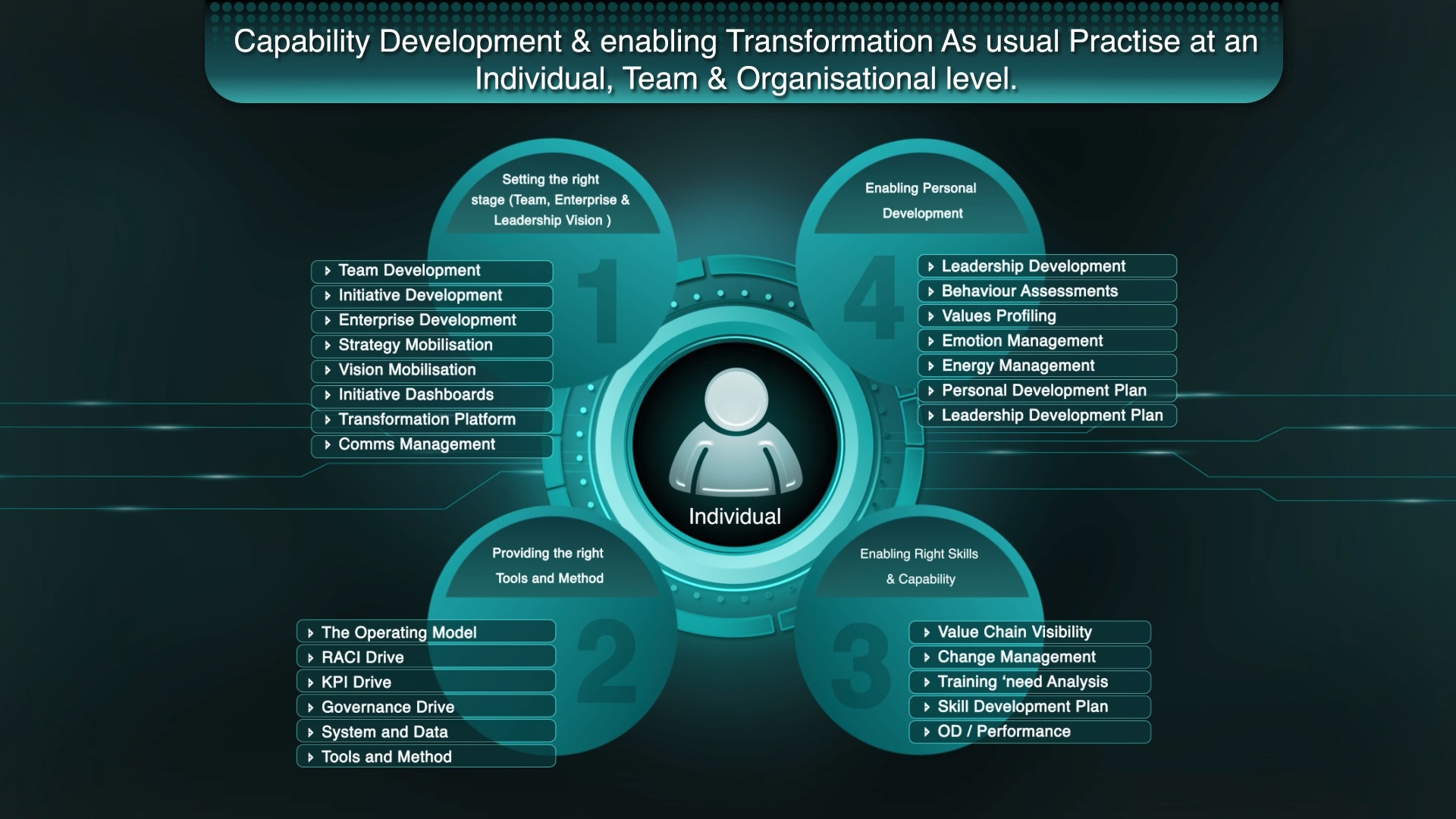Retail Departmental – Enterprise Business Transformation
An Introduction To Our Retail Departmental Platform
Modus Business Transformation Core Modules
Building, Driving and Sustaining your Business Transformation and embedding a 'Transformation As Usual' platform.
*01 - Business Model Management Hub in Modus ETP for Retail Departmental Enterprises
Transform your Retail Departmental enterprise with the Business Model Management Hub in Modus ETP. Adapt, optimize, and grow your business effortlessly.
Key Features:
• Value Chain Integration: Connects all aspects of the retail value chain for
end-to-end visibility in sourcing, merchandising, and sales.
• Automated Process Tracking: Tools for automated monitoring of key
functions like pricing, inventory, and demand forecasting.
• Customizable Dashboards: Real-time, role-based dashboards provide
tailored insights for managing retail operations.
• Change Management: Ensures change requests and updates align with
long-term business goals.
Benefits:
• Increased Productivity: Automation allows teams to focus on strategic tasks.
• Cost Efficiency: Optimizes resource allocation to minimize unnecessary
costs.
• Agility: Enables swift response to market changes with real-time insights.
• Improved Customer Satisfaction: Supports better personalization and
engagement with integrated customer data.
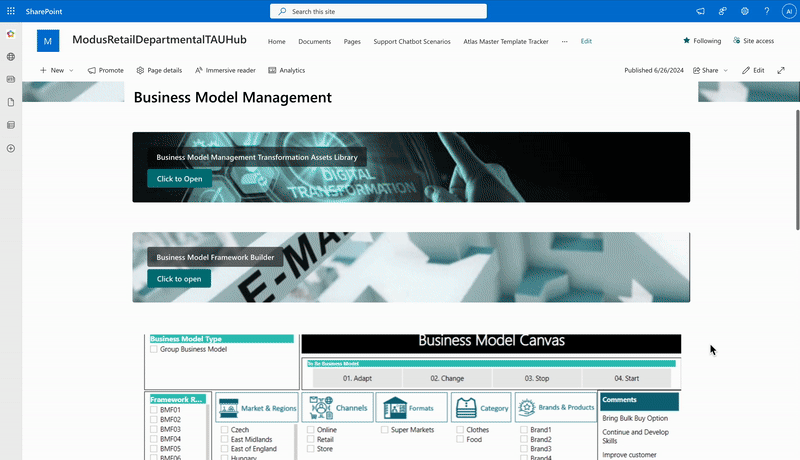
Importance:
• Alignment of Strategy and Operations: Syncs business operations with
strategy, enabling effective execution across departments.
• Improved Decision-Making: Integrated data and reporting empower informed
decisions on supply chain, pricing, and promotions.
• Consistency Across Teams: Provides a unified platform for consistent
strategy execution across regions and departments.
• Efficiency in Transformation: Maintains alignment between operations and
strategic goals, accelerating new business model implementation.
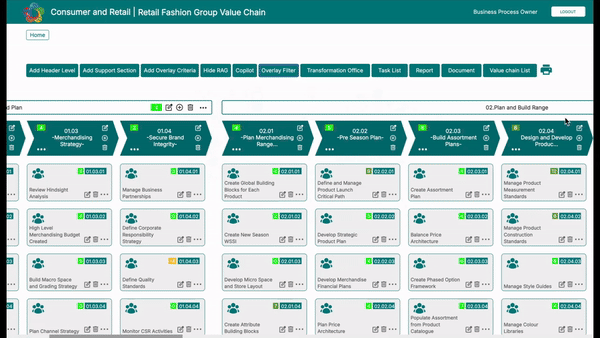
Benefits:
• Optimized Inventory Management: Tracks stock levels in real-time, reducing
overstock and stock-outs.
• Cost Savings: Identifies inefficiencies and offers insights for cost reduction in
supply chain and merchandising.
• Enhanced Customer Satisfaction: Improves product availability and service
speed for a better customer experience.
• Greater Flexibility: Allows retailers to adapt quickly to market changes,
maintaining competitiveness.
*02 - The Value Chain Modeler - Manage and Adapt
Transform your Retail Departmental enterprise with the Value Chain Modeler in Modus ETP. Understand, optimize, and grow your business seamlessly.
Key Features:
• End-to-End Visibility: Full visibility across the retail value chain, from
procurement to delivery.
• Real-Time Data Integration: Enables instant adjustments to inventory,
pricing, and demand.
• Customizable Dashboards: Role-specific dashboards provide real-time
insights for better decision-making.
• Scenario Planning: Tools for assessing impacts of pricing changes or supply
chain disruptions.
Importance:
• Strategic Alignment: Aligns daily operations with broader retail strategies to
achieve business goals.
• Improved Responsiveness: Real-time data helps retailers quickly adapt to
market changes.
• Operational Efficiency: Identifies bottlenecks, boosting productivity and
reducing costs.
• Data-Driven Decisions: Integrated reporting improves decision accuracy and
speed.
*03 - The Operating Model - Organize and Sustain
Transform your retail departmental enterprise with the Operating Model in Modus ETP. Organize, sustain, and optimize your operations for ongoing success.
Key Features:
• Real-Time Overview: Provides live updates on retail operations, from supply chain to customer service.
• Multi-Level Design: Aligns high-level strategy with daily operations across six
structured levels.
• Integrated Change Management: Tracks and manages shifts from the
current to the desired operational model.
• Continuous Alignment: Ensures real-time updates to KPIs, roles, systems,
and processes.
Benefits:
• Cost Efficiency: Streamlines processes to reduce operational costs.
• Enhanced Decision-Making: Offers detailed insights for data-driven
decisions.
• Scalable Change Management: Ensures uniform execution of changes
across locations and departments.
• Continuous Improvement: Optimizes the operating model to adapt to market
and internal changes.
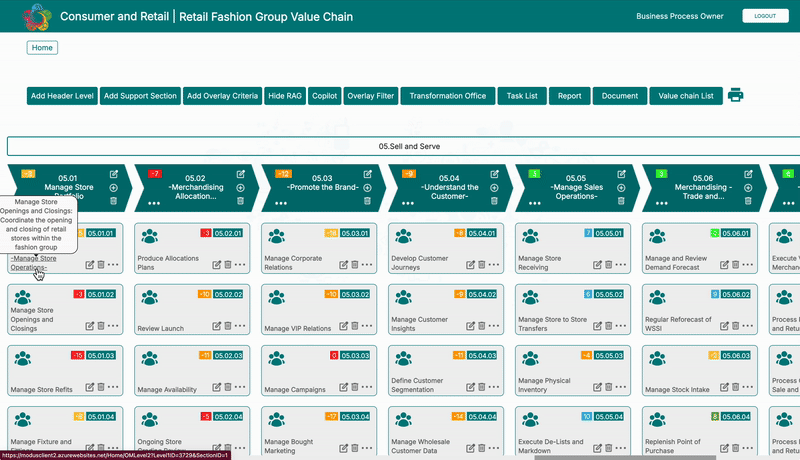
Importance:
• Strategic Alignment: Connects daily retail operations to strategic business
goals.
• Enhanced Flexibility: Enables real-time adjustments for quick responses to
market or supply chain changes.
• Improved Efficiency: Identifies bottlenecks and optimizes resource allocation
for better performance.
• Operational Consistency: Keeps policies, training, and processes aligned
across teams and locations.
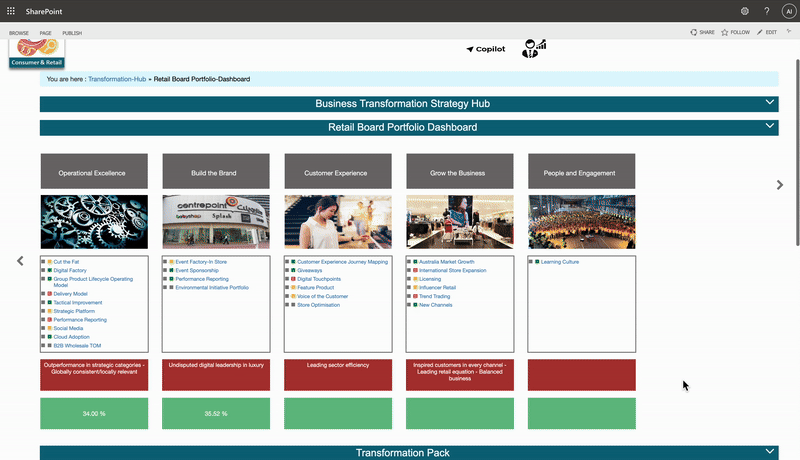
Key Assets:
• Enhanced Collaboration: Cross-team collaboration is facilitated by shared
assets and insights, improving productivity across retail departments and
stakeholders.
• Increased Agility: Enables quicker responses to market changes and
customer demands, giving retailers the flexibility needed to stay competitive.
• Cost and Time Efficiency: Automating transformation processes and using
predefined templates reduces the time and costs associated with deploying
new strategies.
• Scalable Solutions: The platform supports scaling transformation efforts
across multiple departments or locations, ensuring uniformity and efficiency.
*04 - The Transformation Assets and Portfolio Module - Discover and Transform
The Transformation Assets and Portfolio Module, a core part of the Modus Enterprise Transformation Platform (ETP), helps retail enterprises streamline operations and achieve their transformation goals. It provides a library of templates and methods for a structured, efficient approach to execution.
Key Features:
• Centralized Asset Bank: Repository of 400+ assets, including templates and
tools, for retail transformation.
• Integrated Portfolio Management: Manages multiple projects with automated
reporting and templates.
• Customizable Dashboards: Role-specific, real-time insights for managing
transformation progress.
• Agile Transformation Management: Supports agile methods for both
individual projects and large portfolios.
Importance:
• Streamlined Transformation: Centralizes efforts, ensuring alignment with
business goals.
• Optimized Resource Management: Enhances control over resources,
timelines, and dependencies.
• Improved Visibility: Integrated reporting ensures progress tracking and
accountability.
• Consistency in Delivery: Maintains quality and efficiency across retail
projects.
• Value Chain Analysis
• Business Model Analysis
• Transformation Strategy
• Transformation Mobilisation
• Planning Management
• Transformation Log Management
• Financial Management
• Communication Management
• Operating Model Management
• Process Design Management
• IT Design Management
• Build and Test Management
• Implementation Management
• Change Management
• Personal Development Assessments
• Training Management
• Organizational Design Management
• Transformation Review
• Optimization and Governance
5. Organizational Change Management in Modus ETP
Transform your retail departmental enterprise with Organizational Change Management in Modus ETP. Unite, thrive, and achieve your change goals with confidence.
Key Features:
• Robust Change Management: The OCM Hub offers tools, templates, and
techniques to manage change across retail portfolios.
• Real-Time Tracking: Integrated dashboards provide real-time monitoring and
reporting of change processes.
• Customizable Methods: Retail teams can adopt or digitize their preferred
change management methodologies.
• Cross-Team Collaboration: Facilitates alignment and communication across
all teams involved in the change process.
Importance:
• Smooth Transitions: Ensures coordinated change management without
disrupting operations.
• Strategic Alignment: Aligns organizational changes with long-term business
goals.
• Accelerated Adoption: Speeds up change adoption at team and individual
levels. Continuous Improvement: Allows ongoing updates to transformation
strategies to meet market demands.

Benefits:
• Enhanced Efficiency: Automates the change management process, reducing
time and resources needed for implementation.
• Improved Stakeholder Communication: Keeps all stakeholders informed via
an integrated communications platform, reducing friction.
• Minimizes Disruption: Aligns change with operational capabilities, ensuring
seamless integration with minimal impact.
• Scalable Change Management: Scales initiatives across locations, ensuring
consistent application of best practices.
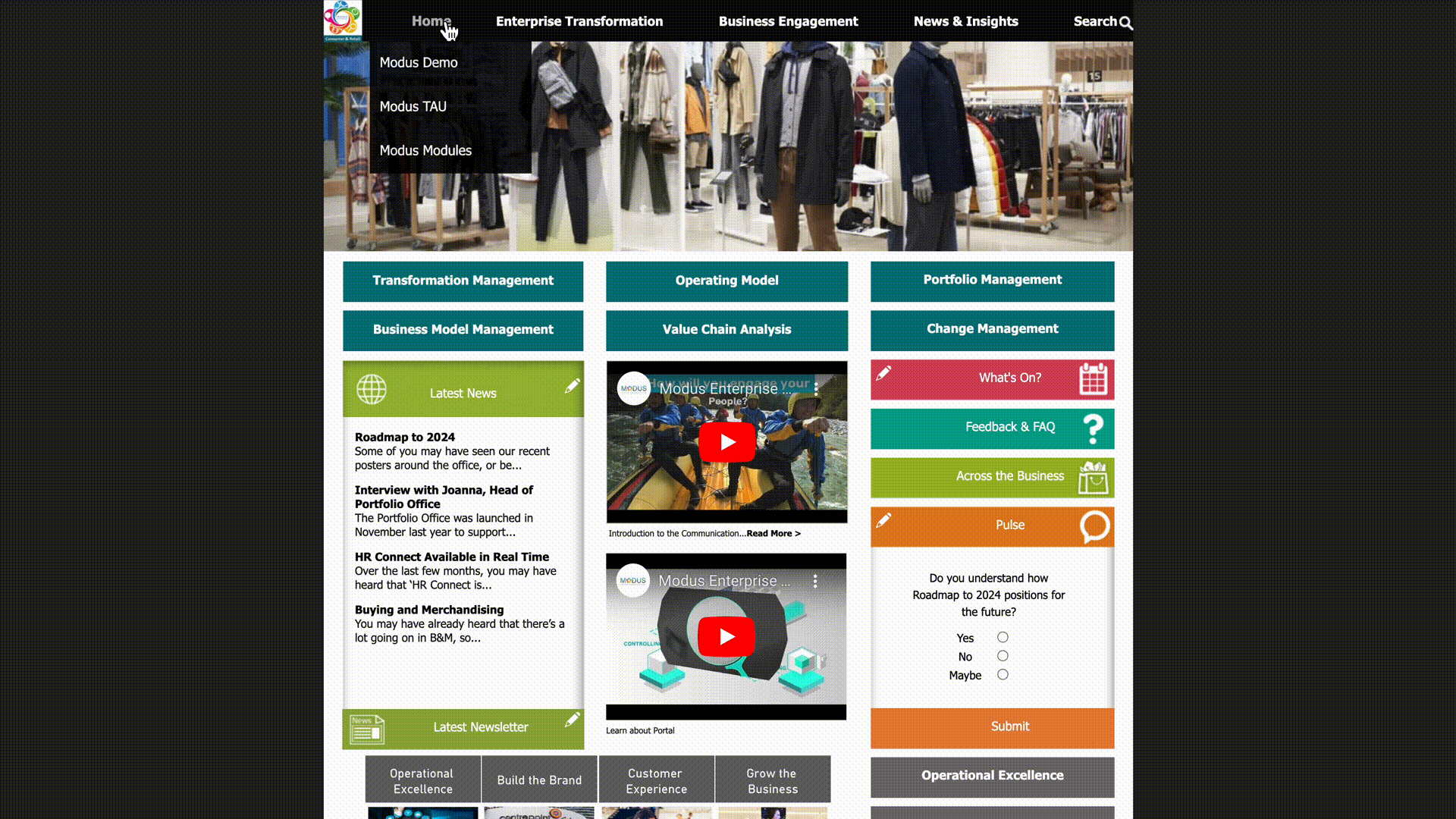
Importance:
• Improved Cross-Brand Collaboration: Enhances communication between
retail brands and functions, facilitating a unified approach to transformation
across the conglomerate.
• Increased Stakeholder Engagement: Ensures that all team members, from
executives to frontline staff, are aligned with the transformation strategy,
boosting engagement and ownership of change.
• Streamlined Information Access: Provides quick and easy access to
essential documents, reports, and schedules, reducing delays and
miscommunications during the transformation process.
• Boosted Productivity: With real-time notifications and role-based content, the
hub ensures timely actions, keeping transformation projects on track and
enabling teams to focus on high-priority tasks.
*06 - Engagement Hub - Share and Guide
Transform your retail departmental enterprise with the Engagement Hub in Modus ETP. Centralize communication, stay informed, and guide your teams through successful transformations.
Key Features:
• Centralized Platform: Offers a unified interface for all team members to
access transformation materials, reports, and updates.
• Real-Time Communication: Enables instant collaboration and timely updates
across teams and stakeholders.
• Role-Based Access: Customizes user views and access to relevant data and
tools based on responsibilities.
• Commitments Tracking: Tracks training, meetings, and deadlines to ensure
timely completion.
Benefits:
• Boosts Productivity: Streamlines communication and access to information,
improving team efficiency.
• Enhanced Collaboration: Facilitates cross-team collaboration with real-time
updates.
• Consistent Alignment: Centralizes transformation activities, keeping
business and transformation teams aligned.
• Ongoing Learning: Ensures access to training materials, helping teams
adapt to changes effectively.
Transformation As Usual Capability Model
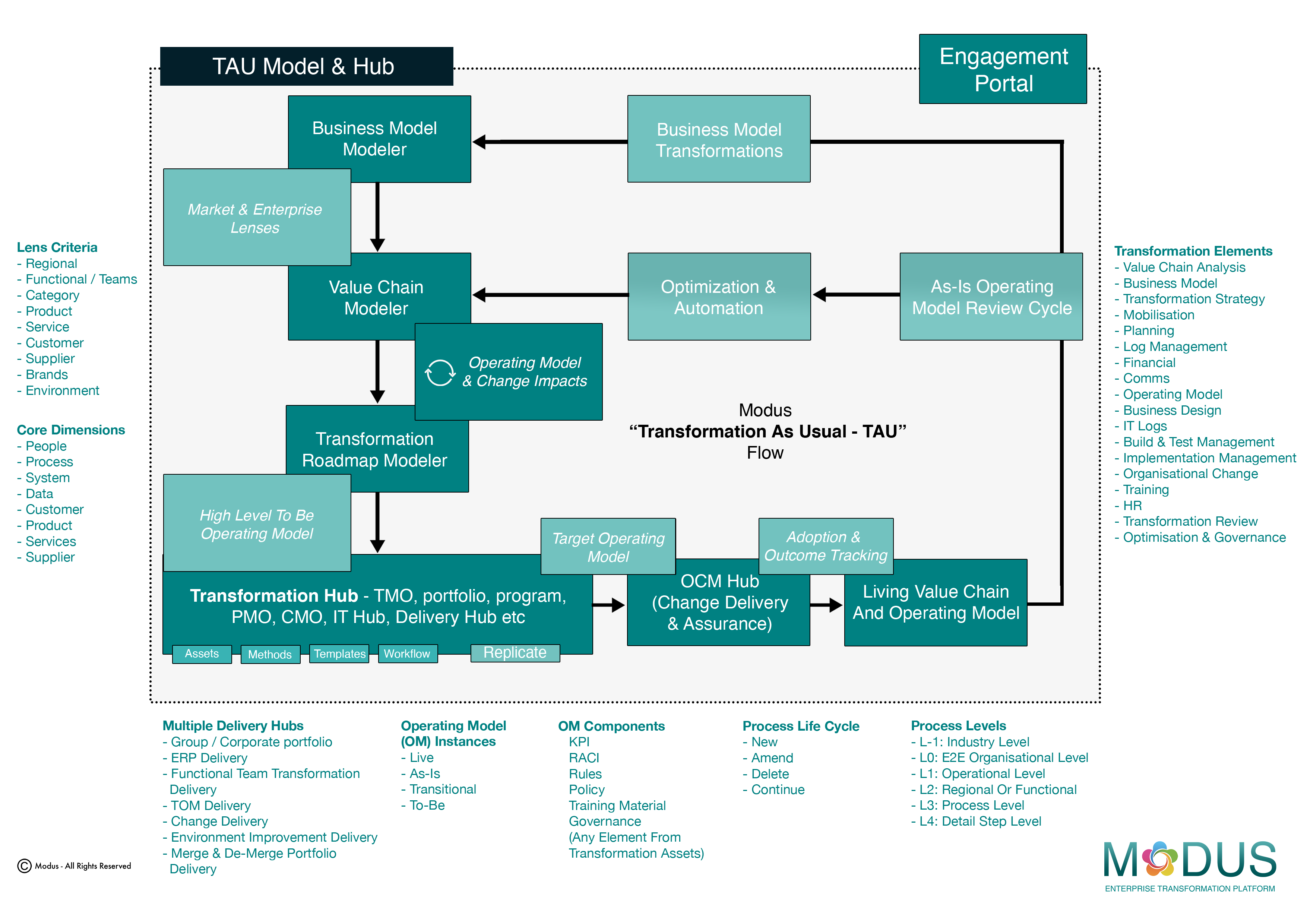
Individual and Team Capability Development
